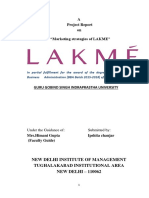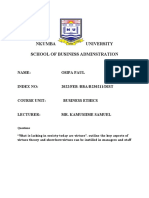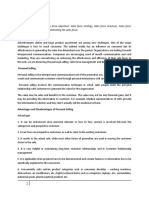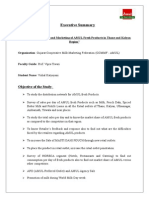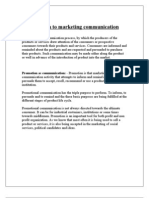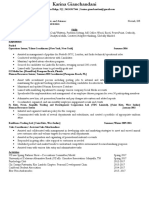0 ratings0% found this document useful (0 votes)
104 viewsLesson 46 Personal Selling
Lesson 46 Personal Selling
Uploaded by
Ajay SinghCopyright:
Attribution Non-Commercial (BY-NC)
Available Formats
Download as DOCX, PDF, TXT or read online from Scribd
Lesson 46 Personal Selling
Lesson 46 Personal Selling
Uploaded by
Ajay Singh0 ratings0% found this document useful (0 votes)
104 views5 pagesOriginal Title
Lesson 46 personal selling
Copyright
© Attribution Non-Commercial (BY-NC)
Available Formats
DOCX, PDF, TXT or read online from Scribd
Share this document
Did you find this document useful?
Is this content inappropriate?
Copyright:
Attribution Non-Commercial (BY-NC)
Available Formats
Download as DOCX, PDF, TXT or read online from Scribd
Download as docx, pdf, or txt
0 ratings0% found this document useful (0 votes)
104 views5 pagesLesson 46 Personal Selling
Lesson 46 Personal Selling
Uploaded by
Ajay SinghCopyright:
Attribution Non-Commercial (BY-NC)
Available Formats
Download as DOCX, PDF, TXT or read online from Scribd
Download as docx, pdf, or txt
You are on page 1of 5
Lesson 46 personal selling - concept and process - Document Transcript
1. Marketing Management Unit 4 Delivering Marketing Programs Chapter 14 -
Promotion-Decisions and Strategies Lesson 46 - Personal selling - concept and processing
previous chapter we have discussed about Direct marketing and its growth ,importance and
channels of direct Marketing. Let us move on to another component of promotion mix-
Personal selling. You all have probe-ably experienced personal selling efforts. Have you ever
bought something from the door salesman ? Do you find personal selling efforts worth
appreciating or have you found themiritatating? Personal selling is somewhat different from
other promotion components . Do you agree ? Lets get started and know it better………
Students you would agree that personal selling is the most adaptable of all promotion
methods because the person who is presenting the message can modify it to suit the
individual buyer. However, personal selling is also the most expensive promotion method.
Lets define personal selling now…Personal selling is paid personal communication that
attempts to inform customers and persuade them to purchase products or services.You would
agree that it is the personal selling process that allows marketers the greatest freedom toadjust
a message to satisfy customers’ information needs. Personal selling allows the marketer
orseller to communicate directly with the prospect or customer and listen to his or her
concerns, an-swer specific questions, provide additional information, inform, persuade, and
possibly even recom-mend other products or services.It would be interesting for you to know
that personal selling is one of the oldest forms of promotion.It involves the use of a sales
force to support a push strategy (encouraging intermediaries to buythe product) or a pull
strategy (where the role of the sales force may be limited to supportingretailers and providing
after-sales service).Let us look at how personal selling facilitates marketers :- The greatest
freedom to adjust a message to satisfy customers informational needs, dynamic. Most
precision, enabling marketers to focus on most promising leads. vs. advertising, publicity and
sales promotion Give more information Two way flow of information, interactivity.16.101G
© Copy Right : Rai University 463
2. Marketing Management Discover the strengths and weaknesses of new products and
pass this information on to the marketing department. Highest cost. Businesses spend more
on personal selling than on any other form of promotional mix. Goals range from finding
prospects convincing prospects to buy keeping customers satisfied—help them pass the word
along.KINDS OF SALESMENLet us know about kinds of salesmen . Can you give some
examples ? Have you met different kindof sales people ? Following are some categories of
sales personA. Salespersons may be order getters, order takers, and support personnel. A
single individual can, and often does, perform all three functions.1. Order Getters. An order
getter is responsible for what is sometimes called creative selling: selling the firm’s products
to new customers and increasing sales to present customers.a. An order getter must perceive
buyers’ needs supply customers with information about the firm’s product, and persuade
them to buy the product.b. Order-getting activities fall into two groups.1. In current-customer
sales, salespeople concentrate on obtaining additional sales.2. In new-business sales, sales
personnel seek out new prospects and convince them to make an initial purchase.2. Order
Takers. An order taker handles repeat sales in ways that maintain positive relationships with
customers.a. Inside order takers receive incoming mail and telephone orders; they also
include salespersons in retail stores.b. Outside (or field) order takers travel to customers.3.
Support Personnel. Sales support personnel aid in selling but are more involved in locating
prospects, educating customers, building goodwill for the firm, and providing follow-up
service.a. A missionary salesperson usually works for a manufacturer and visits retailers to
persuade them to buy the manufacturer’s products.b. A trade salesperson generally works for
a food producer or processor and assists its customers in promoting products, especially in
retail stores.A technical salesperson assists the company’s current customers in technical
matters.PROS AND CONS OF PERSONAL SELLINGWhat are the advantages of using
personal selling as a means of promotion? Personal selling is a face-to-face activity;
customers therefore obtain a relatively high degree of personal attention The sales message
can be customised to meet the needs of the customer The two-way nature of the sales process
allows the sales team to respond directly and promptly to customer questions and concerns
Personal selling is a good way of getting across large amounts of technical or other complex
product information The face-to-face sales meeting gives the sales force chance to
demonstrate the product Frequent meetings between sales force and customer provide an
opportunity to build good long- term relationshipsGiven that there are many advantages to
personal selling, why do more businesses not maintain a464 © Copy Right : Rai University
16.101G
3. Marketing Managementdirect sales force?Main disadvantages of using personal
sellingThe main disadvantage of personal selling is the cost of employing a sales force. Sales
people areexpensive. In addition to the basic pay package, a business needs to provide
incentives to achievesales (typically this is based on commission and/or bonus arrangements)
and the equipment to makesales calls (car, travel and subsistence costs, mobile phone etc).In
addition, a sales person can only call on one customer at a time. This is not a cost-effective
way ofreaching a large audienceKNOWING PERSONAL SELLING PROCESS Let us know
how the salesperson proceeds with personal selling efforts .Very commonly known are the
following seven steps of personal selling process :-1. PROSPECTING2. PRE-APPROACH3.
APPROACH4. SALES PRESENTATION5. HANDLING OBJECTIONS6. CLOSING
SALE7. FOLLOW UP1. PROSPECTING - Prospecting refers to identifying and developing
a list of potential clients. Salespeople can seek the names of prospects from a variety of
sources including trade shows, commercially-available databases or mail lists, company sales
records and in-house databases, public records, referrals, directories, and a wide variety of
other sources. Prospecting activities should be clearly structured so that they identify only
potential clients who fit the profile and are able, willing, and authorized to buy the product or
service. Once prospecting is underway, it then is up to the sales professional to qualify those
prospects to further identify likely customers and screen out poor leads Let us look at the
prospecting methods in brief : Referrals from customers Trading leads with other sales
representatives (non-competitive) Internal Lists Purchased lists (some interest) Cold calling
(no prior indication of interest)2. PRE-APPROACH - Before engaging in the actual personal
selling process, sales professionals first analyze all the information they have available to
them about a prospect to understand as much about the prospect as possible. During the pre
approach phase of the personal selling process, sales professionals try to understand the
prospect’s current needs, current use of brands and feelings about all available brands, as well
as identify key decision makers, review account histories (if any), assess product needs,
plan/create a sales presentation to address the identified and likely concerns of the prospect,
and set call objectives. The sales professional also develops a preliminary overall strategy for
the sales process during this phase, keeping in mind that the strategy may have to be refined
as hoer she learns more about the prospect. In brief pre-approach would involve the following
:- Does the customer have a need that would be filled by the product/service? Is it financially
possible for the customer to buy? Can the person make or influence the decision?
4. Marketing Management3. APPROACH - The approach is the actual contact the sales
professional has with the prospect. This is the point of the selling process where the sales
professional meets and greets the prospect, provides an introduction, establishes rapport that
sets the foundation of the relationship, and asks open-ended questions to learn more about the
prospect and his or her needs.4. SALES PRESENTATION - During the presentation portion
of the selling process, the sales professional tells that product “story” in a way that speaks
directly to the identified needs and wants of the prospect. A highly customized presentation is
the key component of this step. At this point in the process, prospects are often allowed to
hold and/or inspect the product and the sales professional may also actually demonstrate the
product. Audio visual presentations may be incorporated such as slide presentations or
product videos and this is usually when sales brochures or booklets are pre-scented to the
prospect. Sales professionals should strive to let the prospect do most of the talking during
the presentation and address the needs of the prospect as fully as possible by showing that
hero she truly understands and cares about the needs of the prospect.5. HANDLING
OBJECTIONS - Professional salespeople seek out prospect objections in order to try to
address and overcome them. When prospects offers objections, it often signals that they need
and want to hear more in order to make a fully-informed decision. If objections are not
uncovered and identified, then sales professionals cannot effectively manage them.
Uncovering objections, asking clarifying questions, and overcoming objections is a critical
part of training for professional sellers and is a skill area that must be continually developed
because there will always be objections. Trust me when I tell you that as soon as a sales
professional finds a way to successfully handle “all “his or her prospects’ objections, some
prospect will find a new, unanticipated objection— if for no other reason than to test the
mettle of the salesperson.6. CLOSING SALE - Although technically “closing” a sale happens
when products or services are delivered to the customer’s satisfaction and payment is
received, for the purposes of our discussion will define closing as “asking for the order”.
There are many closing techniques as well as many ways to ask trial closing questions. A trail
question might take the form of, “Now that I’ve addressed your concerns, what other
questions do you have that might impact your decision to purchase?”Closing does not always
mean that the sales professional literally asks for the order, it could be asking the prospect
how many they would like, what colour they would prefer, when they would like to take
delivery, etc. Too many sales professions are either weak or too aggressive when it comes to
closing. If you are closing a sale, be sure to ask for the order. If the prospect gives an answer
other than “yes”, it may be a good opportunity to identify new objections and continue
selling.7. FOLLOW UP - Follow-up is an often overlooked but important part of the selling
process. After an order is received, it is in the best interest of everyone involved for the
salesperson to follow-up with the prospect to make sure the product was received in the
proper condition, at the right time, installed properly, proper training delivered, and that the
entire process was acceptable to the customer. Thesis a critical step in creating customer
satisfaction and building long-term relationships with customers. If the customer experienced
any problems whatsoever, the sales professional can intervene and become a customer
advocate to ensure 100% satisfaction. Diligent follow-up can also lead to uncovering new
needs, additional purchases, and also referrals and testimonials which can be used as sale
stools. WHAT SHOULD A GOOD SALESPERSON DO ?What do you think ? What are the
qualities of a good salesperson? Let us discuss a few of them…..1) Be sincere with people.
Too many salespeople are fake and feign interest in their prospects. People are smart and see
right through such insincerity. If you are not sincere and honest with everyone you meet then
you should not be in sales.2) It is vitally important to constantly hone your sales and
communications skills.
5. Marketing Management and training in formal professional selling techniques is also
very important. Take training classes, listen to audio cassette professional development tapes,
read all the professional development material you can get your hands on, and start a program
of self-study and development in sales today if you haven’t already.3) First listen to your
customer, understand his or her wants and needs, and only then try to deter- mine whether or
not you can deliver the product or services to meet those wants and needs. If you approach a
prospect with a solution before understanding the problem you are likely to be wrong about
the solution.4) The best salespeople ask a lot of questions and genuinely listen to the answers
before speaking again.5) Your prospects and customers are all different so you should treat
them differently.6) The best sales people listen much more than they talk.7) Find out what
your prospects want and then give it to them.8) If you think you cannot make sales then you
probably should not even try. Here is something interesting for you…….APPLICATION
EXERCISE :Review the following article. Share Your views. Shorn close personal -
VARSHA GUPTA & MALIKARODRIGUESTIMES NEWS
NETWORK[ WEDNESDAY,AUGUST 11, 1999 12:32:29 AM ]Marketing in the year 2005:
Virtually all products are available without going to a store. The customer can access pictures
on the Internet, shop among online vendors for the best terms, and click order and payment.
Most companies have built proprietary databases containing information on individual
customer preferences, and use them to “mass-customise” their offerings. Businesses are
doing abetter job of retaining customers by finding imaginative ways to exceed customer
expectations. Companies are focusing on building customer share rather than market share.
An increasing amount of personal selling is occurring over electronic media, mass TV
advertising has greatly diminished. Companies are unable to sustain competitive advantages,
and believe that their only sustainable advantage lies in an ability to learn faster and change
faster. * Philip Kotler, Kotler on Marketing THROW away those stilettos and clogs. Barefoot
days are here. Feel the earth, scream marketers as they wait for the new millennium to unfold.
Trying to be heard above the din of the big M, Indian marketers say, “Let’s go back to the
basics”. Making consumers want - but more essentially, buy -products is what marketing is
about. And this what it will always be about, Y2K or not. As Sergio Zyman, former head of
marketing at The Coca-Cola Company, has put it, “It’s the consumer, stupid.”That’s what
marketers will focus on in the new age. Only, the many ways of getting to the consumer are
evolving at the speed of thought. So it seems only fitting that technology will take over
marketing, and move it from being a science to sounding like science fiction. On the cutting
edge of the century, terms from the lexicons of finance, economics and technology have
found their way onto marketers ‘tongues. Here’s what they’re chanting: E-commerce. Data
mining. EVA. Customer value creation. Decommoditisation and dimensionalisation. All
these are now considered by various battle-scarred marketing warriors to be essential for
survival in the brave new world. But again, while the tools maybe getting increasingly
complicated, it’s all being put to a very simple, single-minded purpose - under-standing
consumers and selling better to them. It’s a goal that most marketers are shooting for, as the
sun sinks lower on this millennium. Ashok Jain, managing director, Cadbury Schweppes
feels that “Marketing made itself so complex that it got lost in its own maze of complexity.”
Sunil Alagh, managing director of Britannia Industries, elaborates on the need for consumer-
study: “New market-
6. Marketing Managementing research will have to focus on understanding in greater
depth the moments of consumption for their products.” More familiarity won’t breed
contempt, it will break common ground. Jain adds, “The consumer will actually become a
customer now.” Millennium marketers will be using a differ-ent box of tools to get more
people to buy more products, more often. In The End of Marketing as We Know It, Sergio
Zyman suggests what he calls ‘dimensional sing’. Simply, if more customers are to buy more
of a product, they will need more reasons to do so. One needs to add newer dimensions to the
image of the product in consumers’ minds. This means looking at consumers in new and
more creative ways, to come up with different appeals for the same old selling proposition.
This will be imperative, as in the absence of a powerful appeal to the emotions, or the
rationale, a consumer will pick on the only differentiator he truly understands: Price.
Technology will make things cheaper, and many will be able to afford the things that only a
few have so far. Says Subroto Sengupta, professor of marketing at IIM Calcutta, “Barefoot
marketing will ride again. There will be a great need for no-frills products and services.”
Walter Viera, presi-dent, Marketing Advisory Services Group, warns that it won’t be only the
mass-market players who’ll have to think value. “Top-end marketers such as Cartier will
have to address the fact that their customers want value even at that price.” It’s specially
important for marketers in this country, feels Rajeev Bakshi, managing director, Cadbury
India, as he believes “India will be a VFM (value for money) products market.” The marketer
of tomorrow will cut his teeth selling to the customer of today. A customer who is smarter,
savvier, and needs more and better reasons to buy. That’s be-cause customers are being spoilt
with increasing choice, they’re becoming more price-sensitive and quality-conscious. They’ll
be more focused on self-satisfaction. Helping them achieve the nirvana of ‘customer self-
empowerment’, will be newer and easier ways to buy - teleshopping, online malls and door-
to-door network marketers all offer a reason to choose their products. The key lies in the
capacity to excite the consumer. Says Abraham Koshy, professor of marketing, IIM-
Ahmadabad: “Newer methods and technologies to understand consumers will evolve. These
in turn automatically take into account the drive towards providing better value to customers.
The concept of relationship marketing will transcend personal relationships to encompass
brand relationships.” So, come 2000, the customer’s kingdom will finally come. And then,
one will see how successful his most faithful courtier’s efforts to keep him satisfied have
been.
You might also like
- HRM AssignmentDocument5 pagesHRM AssignmentShafiulla Baig100% (1)
- Dynamic Nature of Motivation: Buying Motives Meaning and DefinitionDocument13 pagesDynamic Nature of Motivation: Buying Motives Meaning and DefinitionShivam0% (1)
- Consumer Imagery: by Anagha DasDocument36 pagesConsumer Imagery: by Anagha DasMariya RESHMI T.JNo ratings yet
- Personal Selling Concept and ProcessDocument7 pagesPersonal Selling Concept and ProcessSiddhant Yadav100% (1)
- Digital Marketing Vs Traditional MarketingDocument22 pagesDigital Marketing Vs Traditional MarketingPrashant SinghNo ratings yet
- MBA ProjectDocument51 pagesMBA Projectrkray78No ratings yet
- A Comperative Study of Customer Perception in Icici Bank and HDFC BankDocument11 pagesA Comperative Study of Customer Perception in Icici Bank and HDFC BankSourabh Mishra100% (1)
- Final Report On FMGC Sales PromotionDocument34 pagesFinal Report On FMGC Sales PromotionNaresh Rajpurohit Khichan Kot100% (1)
- LakeDocument34 pagesLakeajay sharmaNo ratings yet
- Business Ethics PaulDocument12 pagesBusiness Ethics PaulVANNo ratings yet
- DetailsDocument46 pagesDetailssivakumarp14No ratings yet
- Celeberaty Endorsement On FMCG SectorDocument17 pagesCeleberaty Endorsement On FMCG SectorsalmanNo ratings yet
- Brand Awareness Big Bazar 79 11Document69 pagesBrand Awareness Big Bazar 79 11Rahul KumarNo ratings yet
- Advertising Media: Presented by Rahul Kumar Singh Somnath Maity Bodhisatva SenguptaDocument9 pagesAdvertising Media: Presented by Rahul Kumar Singh Somnath Maity Bodhisatva SenguptaRahul Kumar SinghNo ratings yet
- Unit 10 PricingDocument11 pagesUnit 10 Pricingprabhu shresthaNo ratings yet
- A Study On Mutual Funds in India PDFDocument6 pagesA Study On Mutual Funds in India PDFSahida ParveenNo ratings yet
- Bancassurance: Executive SummaryDocument59 pagesBancassurance: Executive SummarySimran SomaiyaNo ratings yet
- Memoona Asif Pre-Interrogation Assessment PDFDocument2 pagesMemoona Asif Pre-Interrogation Assessment PDFLovely PrincessNo ratings yet
- A Study On Brand Awareness With Special Reference To Sna Oushadhasala Pvt. Ltd. ThrissurDocument55 pagesA Study On Brand Awareness With Special Reference To Sna Oushadhasala Pvt. Ltd. ThrissurT M Jishnu DasNo ratings yet
- Brand Positioning by NokiaDocument71 pagesBrand Positioning by NokiaZizoueZidane100% (3)
- Bloggers Supporting SmeDocument23 pagesBloggers Supporting SmeAditya sengarNo ratings yet
- Brand ManagementDocument30 pagesBrand ManagementmailonvikasNo ratings yet
- Effect of Promotional Activities On The Sales of LubDocument66 pagesEffect of Promotional Activities On The Sales of Lubenbassey100% (2)
- Personal Selling: Presented ByDocument28 pagesPersonal Selling: Presented ByGajendra InwatiNo ratings yet
- BMC Case Study - Vikram V - 18020848018 PDFDocument7 pagesBMC Case Study - Vikram V - 18020848018 PDFVikram VaidyanathanNo ratings yet
- Assignment #2 - Service MarketingDocument5 pagesAssignment #2 - Service Marketingfaye cantil100% (1)
- Project On Maxlife InsuranceDocument41 pagesProject On Maxlife Insurancejigna kelaNo ratings yet
- Presentation - D Mart Ppt-Roll No 70Document21 pagesPresentation - D Mart Ppt-Roll No 70HARSHAL NAIKNo ratings yet
- MKT202 Project FinalDocument11 pagesMKT202 Project FinalfaraseeNo ratings yet
- Project Report On: Topic: Bancassurance Submitted By: NAME: Joyeeta Das SEAT NODocument60 pagesProject Report On: Topic: Bancassurance Submitted By: NAME: Joyeeta Das SEAT NOSunnil ChawlaNo ratings yet
- Types of DemandDocument2 pagesTypes of DemandMujahid Abbas JaffriNo ratings yet
- BSNH02 - CW1 - SampleDocument29 pagesBSNH02 - CW1 - SampleShaikh FarhaNo ratings yet
- Brand Positioning Definition and ConceptDocument9 pagesBrand Positioning Definition and ConceptV SHARAVANI MBANo ratings yet
- FSC MR 15Document50 pagesFSC MR 15Shitanshu YadavNo ratings yet
- Avanti Feeds CRMDocument73 pagesAvanti Feeds CRMkeerthiNo ratings yet
- ESDM2013049Document4 pagesESDM2013049Sandy NairNo ratings yet
- Jntu Parachute Hair Oil Plagriaism Free FileDocument63 pagesJntu Parachute Hair Oil Plagriaism Free Filechaithanya chaithuNo ratings yet
- LIC Brand Loyalty PDFDocument16 pagesLIC Brand Loyalty PDFRasika Pawar-Haldankar0% (1)
- Unit I Introduction To MarketingDocument12 pagesUnit I Introduction To Marketingsai ramNo ratings yet
- SampleDocument42 pagesSampleMeet LalchetaNo ratings yet
- Project Report On Sales PromotionDocument86 pagesProject Report On Sales PromotionKelavanidham CSC AhmedabadNo ratings yet
- A Study On Working Women and Their InvestmentDocument70 pagesA Study On Working Women and Their InvestmentRITIKA PATHAKNo ratings yet
- Consumer Needs & Motivation: Meaning, Classification and Theories of MotivationDocument36 pagesConsumer Needs & Motivation: Meaning, Classification and Theories of Motivationanindya_kunduNo ratings yet
- A Study On Brand Switching Factors of Millennial Customers On ToiletriesDocument43 pagesA Study On Brand Switching Factors of Millennial Customers On ToiletriesNandhaGopal RamasamyNo ratings yet
- 7.impact of Social Media Influencers On Consumer Buying DecisionsDocument10 pages7.impact of Social Media Influencers On Consumer Buying Decisionsbabydoll63940100% (1)
- Dimple Report FinalDocument26 pagesDimple Report Finaljuhi jainNo ratings yet
- Birla Sunlife InsuranceDocument64 pagesBirla Sunlife InsuranceNithin ThinaNo ratings yet
- Advertisement Effectiveness of Cold DrinksDocument71 pagesAdvertisement Effectiveness of Cold DrinksRahul Kumar Jha100% (1)
- Finextra Fintech Marketing Report 2014 110914Document45 pagesFinextra Fintech Marketing Report 2014 110914Jaskeerat SinghNo ratings yet
- KIRAN PRojectDocument69 pagesKIRAN PRojectMunna Munna100% (2)
- Questioning and Negotiation PrincipleDocument3 pagesQuestioning and Negotiation PrincipleSUVOLAKSHMI MUKHOPADHYAYNo ratings yet
- Q What Is Buying MotivesDocument1 pageQ What Is Buying MotivesRonsai editzNo ratings yet
- A Study On Whether Taxtion Is A Seeling Cool For Life InsuranceDocument7 pagesA Study On Whether Taxtion Is A Seeling Cool For Life InsuranceDEEPAKNo ratings yet
- A Study On Impact of Financial Crisis On Indian Mutual FundsDocument86 pagesA Study On Impact of Financial Crisis On Indian Mutual FundsTania MajumderNo ratings yet
- Survey On Comparative Analysis of Max Life Online Term Plan Plus and ICICI Prudential IProtect Smart Plan PGDMDocument44 pagesSurvey On Comparative Analysis of Max Life Online Term Plan Plus and ICICI Prudential IProtect Smart Plan PGDMAlok kumarNo ratings yet
- Green Products A Complete Guide - 2020 EditionFrom EverandGreen Products A Complete Guide - 2020 EditionRating: 5 out of 5 stars5/5 (1)
- Personal SellingDocument6 pagesPersonal SellinggunflayercsgoNo ratings yet
- Sales PolicyDocument23 pagesSales Policyfsetncho721No ratings yet
- Chapter 5: Promotion Strategy in International Context: Types of Personal SellingDocument9 pagesChapter 5: Promotion Strategy in International Context: Types of Personal SellingLamesa DarajeNo ratings yet
- Complete Notes (SCM)Document187 pagesComplete Notes (SCM)Scroll with deepriyaNo ratings yet
- IKEA Case StudyDocument24 pagesIKEA Case StudyVinayak ChennuriNo ratings yet
- Zero To One SummaryDocument10 pagesZero To One SummaryAlain100% (1)
- SFCM PPT ContentDocument2 pagesSFCM PPT ContentPratik R PanchalNo ratings yet
- FAQ's Aggregate: Your Frequently Asked QuestionsDocument9 pagesFAQ's Aggregate: Your Frequently Asked QuestionsHeanNo ratings yet
- MCQ MarketingDocument13 pagesMCQ MarketinglindakuttyNo ratings yet
- Gamon Plus v. Campbell Soup - ComplaintDocument180 pagesGamon Plus v. Campbell Soup - ComplaintSarah BursteinNo ratings yet
- Analysis of Marketing Communication of Amway and Tupper WareDocument32 pagesAnalysis of Marketing Communication of Amway and Tupper WareNeha Saxena67% (3)
- Trouble Brews at Starbucks: - Lauranne Buchanan and Carolyn Simmons 2009Document14 pagesTrouble Brews at Starbucks: - Lauranne Buchanan and Carolyn Simmons 2009Rahul100% (1)
- Aptitude 3Document6 pagesAptitude 3muthupecmec4908No ratings yet
- Den TonicDocument23 pagesDen Tonickzm3No ratings yet
- Pressed 703 1015Document313 pagesPressed 703 1015GokulNo ratings yet
- Solitude Owner Manual Rev0613Document154 pagesSolitude Owner Manual Rev0613laffmanNo ratings yet
- ResumeDocument1 pageResumeapi-361726508No ratings yet
- Financial Statements: BAO6504 Accounting For ManagementDocument20 pagesFinancial Statements: BAO6504 Accounting For ManagementDaud SulaimanNo ratings yet
- Purchase Authorisation Form: 3rd Sep-19 ShoppeshopDocument3 pagesPurchase Authorisation Form: 3rd Sep-19 ShoppeshopVinay MishraNo ratings yet
- Handicrafts Export Promotion Council Additional ExtraDocument27 pagesHandicrafts Export Promotion Council Additional ExtraManasa PriyaNo ratings yet
- Chapter5 Principles of Accounts For Caribbean StudentsDocument13 pagesChapter5 Principles of Accounts For Caribbean StudentssamNo ratings yet
- Kraljic Matrix of Procurement 20022015 PDFDocument4 pagesKraljic Matrix of Procurement 20022015 PDFMax Bull TerrierNo ratings yet
- Andre Wijaya, Reynaldi, KahfiDocument8 pagesAndre Wijaya, Reynaldi, KahfiAndre WijayaNo ratings yet
- Budgetry ControlDocument2 pagesBudgetry ControlShaji KuttyNo ratings yet
- Smart WaterDocument55 pagesSmart WaterAshraf AhmedNo ratings yet
- Haliyal Sugar IndustryDocument50 pagesHaliyal Sugar IndustryStany D'melloNo ratings yet
- The AIDA Model in SalesDocument4 pagesThe AIDA Model in SalesADNo ratings yet
- Mgt. AccountingDocument12 pagesMgt. AccountingIan Joseph Lagera CalpitoNo ratings yet
- 82 - Teder file1BTDocument13 pages82 - Teder file1BTAmbuj SahooNo ratings yet
- Transportation Manager or Vice President of Transportation or SaDocument1 pageTransportation Manager or Vice President of Transportation or Saapi-78171289No ratings yet
- Mini Case StudyDocument3 pagesMini Case StudyAry AntoniettoNo ratings yet
- Brand Inventory OreoDocument6 pagesBrand Inventory OreoYatinNo ratings yet
- Segmentation, TargetingDocument27 pagesSegmentation, TargetingRajesh ShresthaNo ratings yet








